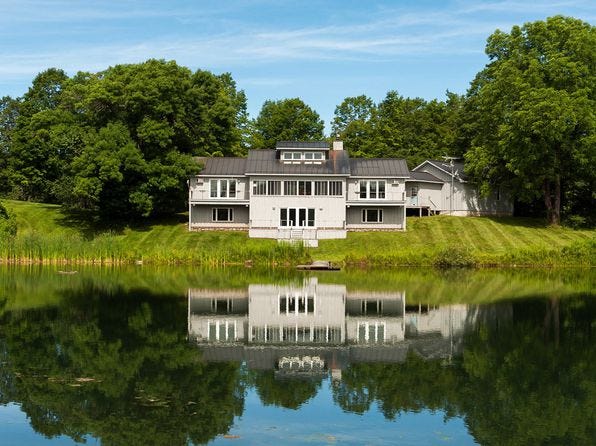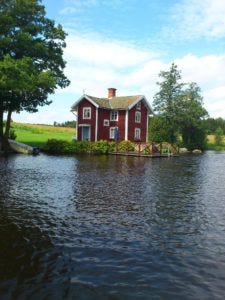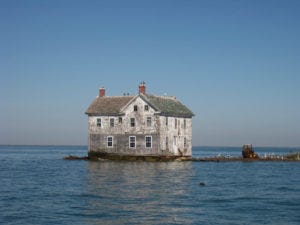Written By Malcolm Lawson
Whether it’s on an ocean, lake, river or bay, there is just something that people love about being near the water. Because of this, Maryland waterfront homes are very popular among state residents. Many people dream of living near the water. While there are great benefits to living on the waterfront, there are 4 critical things to know when buying a waterfront home!

Do You Know The Difference Between Riparian vs. Non-riparian Rights?
When you are looking at waterfront property, you will have two choices: riparian or non-riparian. Understanding these two terms is crucial.
Maryland Riparian Rights
When Maryland waterfront homes have riparian rights it means that they have a deed that extends all the way to the water’s edge. The water (ocean, bay, river, stream, etc.) actually forms one of the property’s boundary lines. When you own riparian rights you have direct access to the water and the right to extend use into the water (ex: building a pier) with the approval of the local government. An important restriction on this regulation is that your right to extend and improve your lot cannot encroach upon the neighbours’ rights.
Maryland Non-Riparian Rights
When a home is non-riparian it means that there is water access, but the property leading up to the water is not owned by the homeowner. It is typically owned by a community association or county. In most cases, a house that does not have riparian rights means the homeowner does not have a pier or dock in the water. However, there are communities that will grant the owners access to the water.

Maryland Waterfront Regulations You Need To Know!
Homeowners with waterfront property have many rules and regulations that they must follow. Before making an offer on any Maryland waterfront homes, you will want to understand what regulations apply and how they will impact you.
Maryland’s Critical Area Regulations
Back in 1984 in an effort to protect the Chesapeake Bay and the surrounding habitat, the Maryland General Assembly created the Chesapeake Bay Critical Area Protection Program. A Critical Area Commission, along with 61 local governments work to protect the land in the “critical area”, which includes 1000 feet inward from all tidal influence for the Bay. This program’s goal is to protect the future health of the bay by restricting and controlling the development that is taking place in these crucial areas. What does this mean to you?
A Critical Area Buffer has been established as the 100 feet adjacent to the tidal waters, tidal wetlands, and tributary streams. In this buffer area, there are shrubs, plants and trees that help to protect against runoff water that can erode the land and carry pollutants into the water. If you own property that is within the critical area you will be restricted to the use of your land within the established regulations, or at the very least you will need to request approval to develop your land.
Important Details about the Critical Area Buffer
- You cannot remove trees within the Critical Area unless you are replacing them with new trees. You might be required to replace at higher than a 1:1 ratio. If you are in the buffer you will only be able to remove trees that are dead, dying, diseased or a hazard on the property.
- In most cases building on property within the Critical Area is permitted, but you will want to consult with your local zoning board for all rules and regulations in your specific situation.
- Depending on the location of the property, there could be restrictions on the total amount of lot coverage you can have. Lot coverage includes the land that is covered by man-made materials.
- If you live in the Buffer zone you might be required to submit a Buffer Management Plan prior to making changes on your property, even for work such as tilling a large garden. It is always best to inquire with the local government if you are unsure of the regulations.
If you are planning on building or modifying a waterfront home then I recommend contacting your counties local planning office to determine if it will be in a critical area and what limitations or requirements may be required for that Critical Area.

Maryland Mean Low Water Levels
If you are a boater then another important factor you want to consider when looking at waterfront property is the mean low tide. This is the average level of low tide. For a small to mid-size boat, I recommend looking for at least 3–4 ft. If you have a larger sailboat you may require more. If you only plan on using a small kyaks or rafts the 1–3 ft may be all you need.
Thinking of moving to Maryland? Here are the pros and cons of living in Maryland.
Communities and HOA
If you are buying a waterfront house that is in a developed community or is part of a Home Owners’ Association, you need to inquire about the regulations that they have established. Many times communities and HOAs will hold the riparian rights to waterfront properties. You need to know what maintenance you are required for and what the community/HOA provides.

What Type Of Maryland Waterfront Homes Are You Looking For?
The waterfront options in Maryland are endless. Our state has the Chesapeake Bay, Atlantic Ocean and over 50 creeks and rivers. That doesn’t even include lakes and streams. When thinking about living in a waterfront home most people think of the beautiful views and access to the water, however, this isn’t always the case. The state actually owns any land that is underwater and if you aren’t careful you could lose your view and the water access that you thought you had.
- Waterfront Home — Homes that are waterfront mean that they are actually directly on the water. The property that the house is built on goes directly to the waters edge.
- Water Access — If a home has water access it means that you might not have a view, but you can still access the water. Many times the access is granted because your house is in a community that offers water access. This could be a community beach, shared dock, or land that simply meets the water’s edge, even if it has not been maintained.
- Water View — When a house is advertised as having a “water view” it could mean a number of things. Some views are expansive views of large bodies of water, while others are tiny glimpses of water from an upstairs window. It is important to understand that depending on the property that is surrounding your property, your water view could disappear based on the decisions of the neighbors. If the house in front of you adds a second story your water view could be gone forever.

The Importance of Flood Insurance in Maryland
It is a common misconception of Maryland homeowners that their homeowner’s insurance will protect them in the case of a flood. This is not true and if your property is located within a flood zone, you will be required to purchase flood insurance. This speciality insurance is regulated by the National Flood Insurance Program (NFIP). The insurance is costly and the pricing is regulated, which means shopping around will not save you money.
According to marylandfloodinsurance.com back in 2011 Maryland had the 4th highest amount of flood insurance policies in place, behind only Florida, Louisiana and Texas. Before making an offer on a waterfront home, contact the local zoning board to check the flood zone map. The board will be able to tell you what the requirements are for the piece of land.
The rules and regulations involved with Maryland waterfront homes can seem overwhelming, but the work is worth the reward. Once you know the regulations that your property falls under and have closed the deal, you can start to enjoy all that the benefits that the beautiful waters of Maryland have to offer.




